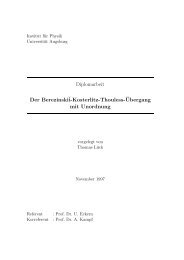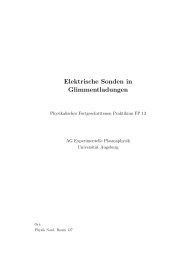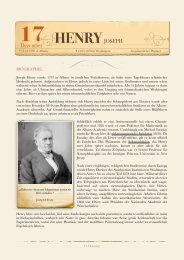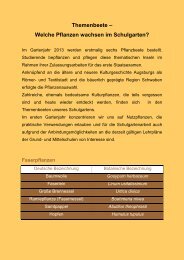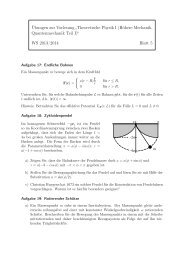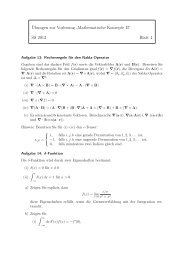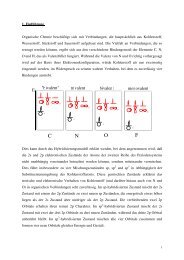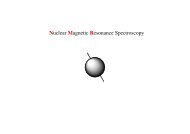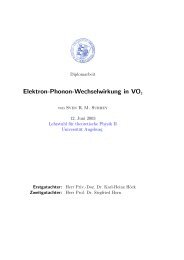Numerical Renormalization Group Calculations for Impurity ...
Numerical Renormalization Group Calculations for Impurity ...
Numerical Renormalization Group Calculations for Impurity ...
You also want an ePaper? Increase the reach of your titles
YUMPU automatically turns print PDFs into web optimized ePapers that Google loves.
2.2. Quantum phase transitions and quantum critical points 9<br />
As an example of such considerations, let us consider the scaling <strong>for</strong>m satisfied<br />
by the two-point correlation C(x, t) defined in Eq. (2.16):<br />
C(x, t) = ZT 1/4 Φ I ( Tx<br />
c , Tt, ∆ ). (2.32)<br />
T<br />
A prefactor, consisting of an overall non-critical normalization constant Z and<br />
T 1/4 , shows consistency of the scaling dimension of the C(x, t). 6 A dimensionless<br />
universal scaling function Φ I has three arguments; time and spatial coordinates<br />
x and t and the energy gap ∆ are combined with a power of T to make the<br />
net scaling dimensions 0 7 . The properties of the two points correlation depends<br />
completely on the ratio of two energy scale, that of the T = 0 energy gap to<br />
temperature: ∆/T. There are two low-T regimes with T ≪ |∆|; the magnetically<br />
ordered side <strong>for</strong> ∆ > 0 and the quantum paramagnetic ground state <strong>for</strong> ∆ < 0.<br />
Then there is a novel continuum high-T regime, T ≫ |∆|, where the physics<br />
is controlled primarily by the quantum critical point ∆ = 0 and its thermal<br />
excitations and is described by the associated continuum quantum field theory.<br />
Here we focus on the last regime and show the structure of the scaling function<br />
in it.<br />
At the quantum critical point (T = 0, ∆ = 0, g = g c ), we can deduce the<br />
<strong>for</strong>m of the correlation by a simple scaling analysis. As the ground state is scale<br />
invariant at this point, the only scale that can appear in the equal-time correlation<br />
is the spatial separation x; from the scaling dimension ˆσ z in Eq. (2.31), we then<br />
know that the correlation must have the <strong>for</strong>m<br />
C(x, 0) ∼<br />
1<br />
(|x|/c) 1/4 (2.33)<br />
at T = 0, ∆ = 0. We can also include time-dependent correlations at this level<br />
without much additional work. We know the continuum theory (2.27) is Lorentz<br />
invariant, and so we can easily extend (2.33) to the imaginary time result<br />
C(x, τ) ∼<br />
1<br />
(τ 2 + x 2 /c 2 ) 1/8 (2.34)<br />
at T = 0, ∆ = 0. This result can also be understood by the mapping to the classical<br />
D = 2 Ising model, where correlations are isotropic with all D dimensions,<br />
and so the long-distance correlations depend only upon the Euclidean distance<br />
between two points.<br />
We extend the result (2.34) to T > 0 by the trans<strong>for</strong>mation<br />
cτ ± ix →<br />
c ( ) πT<br />
πT sin c (cτ ± ix) , (2.35)<br />
6 dim [C(x, t)] = dim [〈σ z (x, t)σ z (0, 0)〉] = 1/4 with dim [T] = z = 1 <strong>for</strong> the given model H I .<br />
7 the velocity c is invariant under the scaling trans<strong>for</strong>mation, i.e. dim[c]=0.



